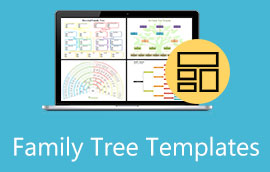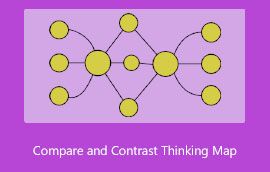Fault Tree Analysis: A Step-by-Step Guide to Identifying System Failures
In intricate systems, grasping the possible breakdowns is essential for maintaining safety, dependability, and effectiveness. Fault Tree Analysis (FTA) is a robust instrument for pinpointing and examining the origins of system failures. It involves methodically deconstructing a system into its parts and locating areas where failure might occur, aiding in proactively managing hazards and enhancing system efficiency. This detailed review will explore the complexities of Fault Tree Analysis, offering a step-by-step approach, discussing its pros and cons, and showing how to construct a fault tree diagram with MindOnMap. It will give you the knowledge and abilities to utilize Fault Tree Analysis proficiently. Join us as we navigate through the potential weak spots in your systems.

- Part 1. What is Fault Tree Analysis?
- Part 2. How to Perform Fault Tree Analysis
- Part 3. Advantages and Disadvantages of Fault Tree Analysis
- Part 4. Draw Fault Tree Analysis Diagram with MindOnMap
- Part 5. FAQs about Fault Tree Analysis
Part 1. What is Fault Tree Analysis?
Fault Tree Analysis (FTA) uses a methodical technique. It finds possible causes of a system's failure. This approach begins at the top with an undesirable outcome (top event) and progresses to uncover the root causes that might result in that event.
Essential elements of FTA
• Top event: The negative result or breakdown of the system.
• Intermediate events: Events that play a role in the top event.
• Basic events: The simplest events that you cannot break.
• Logic gates: Symbols denote logical connections between events (AND, OR, etc.).
Applications of Fault Tree Analysis:
• Employed widely across sectors such as aviation, nuclear energy, and chemical processing to boost the safety and dependability of systems.
• Helps companies understand potential dangers and plan to reduce their impact.
• Supports in pinpointing the reasons behind product flaws and enhancing production methods.
By creating a fault analysis tree that visually illustrates the analysis, FTA aids in comprehending the intricate relationships among system parts and pinpointing critical failure areas. It can be applied to implement preventative actions and enhance the system's dependability.
Part 2. How to Perform Fault Tree Analysis
Executing a successful FTA demands a systematic approach. It involves outlining the unwanted event, finding its causes, and showing these links visually. By meticulously examining the fault tree, companies can rank their efforts to reduce risks and improve the dependability of the entire system.
Fault Tree Analysis (FTA) follows a structured method that includes several critical steps:
Pinpoint the Main Issue
Clearly outline the specific failure or negative event you aim to examine. This is known as the main issue. Decide the extent and limits of the examination to concentrate on the pertinent aspects of the system.
Gather Information
Collect in-depth information about the system. This includes design documents, operational guidelines, maintenance records, and past failure reports. Involve engineers, operators, and specialists who know the system. They can help identify potential failure scenarios.
Build the Fault Tree
Identify the fundamental events or primary causes that could lead to the main issue. These are the terminal nodes of the fault tree. Link the basic events with logic gates (AND, OR, etc.) to show how combinations of events can lead to the main issue.
AND Gate: All input events must happen for the output event to occur.
OR Gate: Any of the input events can trigger the output event.
Examine the Fault Tree
Trace the routes from the basic events through the logic gates to the main issue to understand the relationships and dependencies. If feasible, assign probabilities to the basic events and use these to calculate the likelihood of the main problem.
Identify Key Pathways and Events
Identify which events and pathways have the greatest impact on the likelihood of the main issue. Give priority to the events and components that are most crucial for the system's reliability and safety.
Formulate Mitigation Strategies
Develop strategies to decrease the chance of the main issue by addressing the critical events and pathways. To reduce risks, consider modifying the system's design, operational procedures, or maintenance practices.
Record and Review
Make a complete report of the fault tree analysis. Include all findings, assumptions, and recommended actions. Share the analysis with stakeholders, including management, engineers, and operators, to ensure a mutual understanding and agreement on the proposed strategies.
Monitor and Refine
Monitor the execution of mitigation strategies and their effectiveness in lowering risk. Regularly review and update the fault tree to reflect changes in the system, new insights, or lessons learned from previous failures.
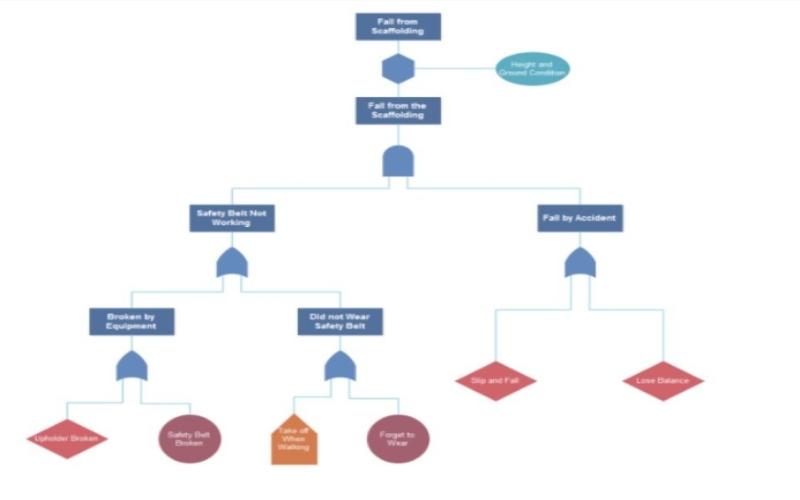
Part 3. Advantages and Disadvantages of Fault Tree Analysis
Benefits of Fault Tree Analysis
• Offers a well-organized framework for examining system failures.• It provides a straightforward and understandable depiction of possible failure routes.• Aids in identifying areas ripe for enhancement.• Capable of gauging the probability of system breakdown.• Successfully simplifies intricate data for stakeholders.
Drawbacks of Fault Tree Analysis
• Larger and more intricate systems can lead to extensive and challenging fault trees.• Creating a detailed fault tree can be a lengthy process.
By grasping the pros and cons of FTA, organizations can adeptly utilize this method to enhance system dependability while keeping its limitations in mind.
Part 4. Draw Fault Tree Analysis Diagram with MindOnMap
Even though MindOnMap is mainly for making mind maps, you can tweak it to make a simple Fault Tree Analysis diagram. It might not be as detailed or customizable as the fancy FTA software, but it's handy for getting ideas flowing and visually seeing things. Using what MindOnMap has to offer, you can make a picture showing how different events are connected, which can help you spot where things might go wrong.
Main Features
• You can change MindOnMap's setup to show the main and related events.
• The tool lets you make a picture map of the fault tree.
• Using different colors for events and logic gates can make things clearer.
• You can also write extra details about events in the text.
Secure Download
Secure Download
Log in if you're already in. If not, create a new account. To kick off a new project, just click the New Project button on the dashboard.
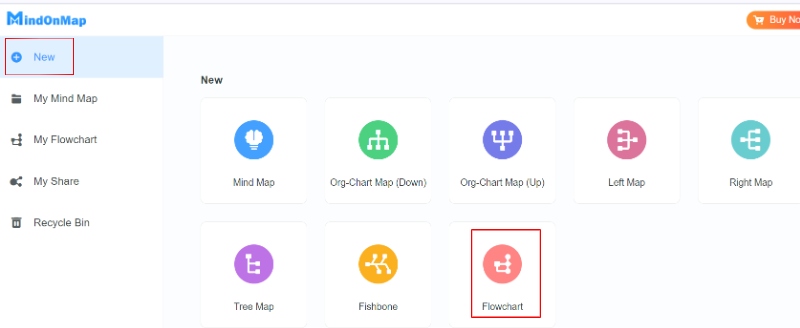
Start by making the main node show the main event or system failure you're looking into. Give your main node a clear name for the main event. You can pick your shapes and themes, too.
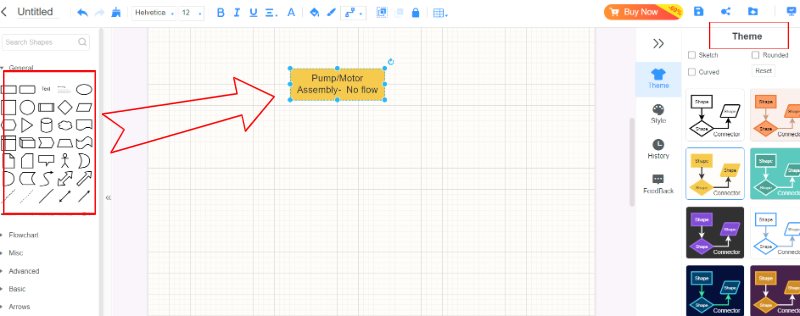
Add smaller nodes that come off the main node. These are the basic events or the main reasons that could lead to the main event. Ensure each basic event node is named well to describe what it's about.
If some events depend on others, add middle nodes to show these connections. Use symbols or words to show AND and OR connections between nodes. Show that all the connected events must happen for the main event, and show that any of the connected events can lead to the main event.
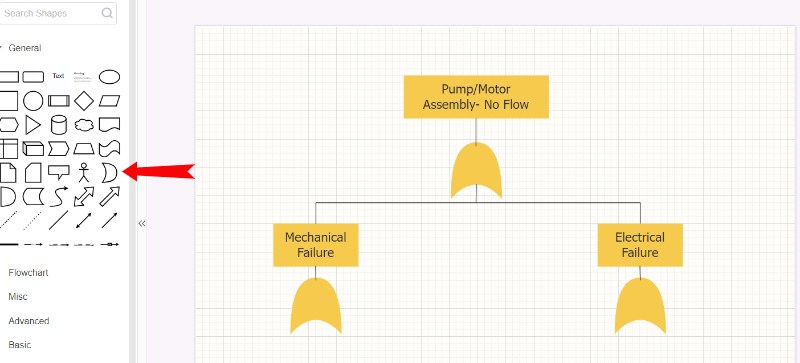
Arrange your fault tree so it's easy to understand, making sure the steps from basic events to the main event flow make sense. Make the nodes and connections stand out by changing their look.
Save your fault tree in a format you like (like PDF or image). Add your fault tree to your project reports or presentations to support your analysis.
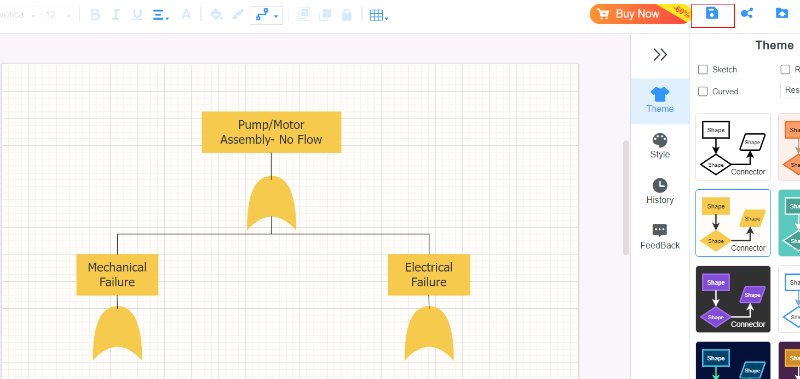
Part 5. FAQs about Fault Tree Analysis
What's the difference between a fault tree analysis and a FMEA?
FTA helps you understand the complex reasons for a failure. FMEA (Failure Mode and Effects Analysis) is great for spotting possible failures and their effects. You can use both together to understand the risks involved fully.
What is Q in fault tree analysis?
In Fault Tree Analysis (FTA), the letter Q usually indicates how likely something will fail or happen. It's a way to measure how probable it is that a certain basic event or failure will happen, which could lead to the main event like a system failure or something bad happening.
What is the primary purpose of a fault tree diagram?
The main goal of a fault tree diagram is to show a clear, neat, and all-inclusive picture of the possible ways a system can fail. It helps us plan for risks and make the system safer.
Conclusion
Fault Tree Analysis (FTA) is a handy tool that helps figure out why systems break down. It shows how different parts are connected and what can go wrong with them in a clear way. Apps like MindOnMap make fault trees easier to create and understand. They help everyone communicate better and make decisions. Even though it needs the right info and know-how, FTA is super useful for managing risks and making systems safer and more dependable.









